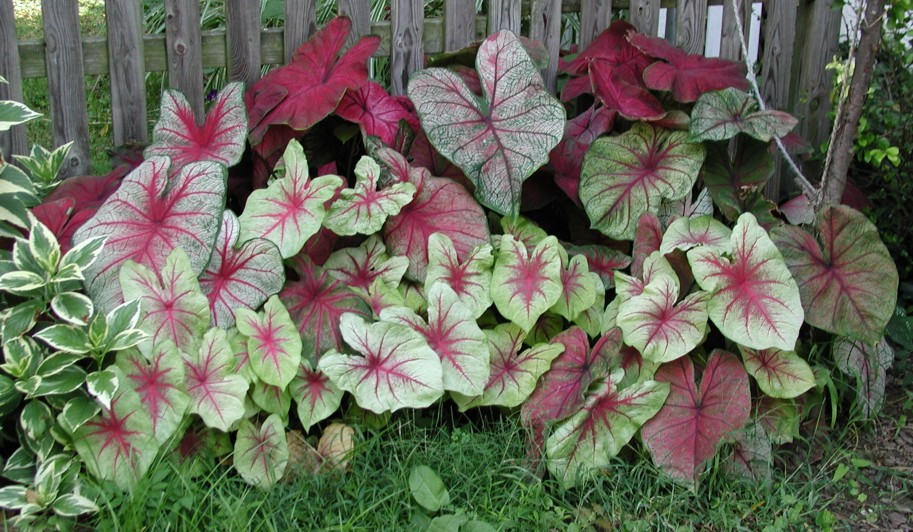- Caladium
:"This article is about a plant whose common names include "Angel Wings" , "Heart of Jesus" and "elephant ear" For other uses for those terms, please see
Angel Wing (disambiguation) andHeart of Jesus (disambiguation) ."Taxobox
name = "Caladium"

image_width = 240px
image_caption = Fancy-leaved caladium
regnum =Plant ae
divisio = Magnoliophyta
classis =Liliopsida
ordo =Alismatales
familia =Araceae
genus = "Caladium"
genus_authority = Vent.
subdivision_ranks = Species
subdivision = See text."Caladium" is a genus of plants of the family
Araceae . They are often known by the common name elephant ear (which they share with the closely related genera "Alocasia ", "Colocasia ", and "Xanthosoma "), Heart of Jesus, [http://www.hear.org/Pier/species/caladium_bicolor.htm Caladium bicolor] ] and Angel Wings. There are over 1000 named cultivars of "Caladium bicolor" from the original South American plant. [http://www.floridata.com/ref/C/cala_bic.cfm Caladium bicolor] ]The genus "Caladium" includes seven species, which are indigenous to
Brazil and to neighboring areas ofSouth America andCentral America . They grow in open areas of theforest and on the banks of creeks and go dormant during thedry season . The wild plants grow to 40-90 cm tall, with leaves mostly 15-45 cm long and broad.;Selected species
*"Caladium bicolor" (syn. "C. marmoratum, C. picturatum, C. hortulanum")
*"Caladium humboldtii"
*"Caladium lindenii"
*"Caladium schomburgkii"Cultivation and uses
Several species are grown as
ornamental plant s for their large, arrowhead-shaped leaves marked in varying patterns in white, pink, and red (somewhat resembling the unrelatedcoleus ) and have been in cultivation inEurope since the late1700s . The two forms most widely cultivated are called "fancy-leaved" and "lance-leaved". The former is the more commonly seen and is the traditional caladium of cultivation; the leaves are more heart-shaped. The latter has more lance-head-shaped leaves. Most Caladiums in cultivation grow to about 60 cm high and 60 cm wide, although dwarf varieties are now in cultivation.Numerous
cultivar s have been selected, most of them (over 120) derived from "C. bicolor". The lance-leaved varieties are also derived from "C. schomburgkii".Caladiums grow from
corm s and can be propagated by dividing the tubers. They are hardy only toUSDA plant hardiness zone 10; in colder areas, they are typically grown as tenderbulb s or ashouseplant s.During their
growing season , they need a great deal of water and should not be allowed to dry out. Most varieties prefer partial to full shade, although sun-resistant varieties are now in cultivation. Approximately 98% of all caladium bulbs are fromLake Placid, FL In temperate areas, they should be lifted before the first frost. The corms are dried and stored for the winter when temperatures fall to 18°C, and stored moderately dry (not bone-dry) over the winter at temperatures between 13 °C and 16 °C.
All parts of the plant are
poison ous. They should not be ingested and may irritate sensitive skin.Public Displays
Every August, a festival is held in "
Lake Placid, Florida ", home to a majority of the world's caladium fields. A popular activity is a tour of the fields of caladiums, the product of local growers. Every July since 2003, "Gaylord Palms Resort & Convention Center " in "Kissimmee, Florida ", has presented the Florida Caladium Showcase, the largest indoor and outdoor display of the plants, including new varieties.Gallery
References
External links
* [http://facultystaff.vwc.edu/~presslar/greenhouse/caladium/xhortulanum/ufces-1060.pdf Brochure on cultivation from the University of Florida Cooperative Extension Service] (
PDF file)
Wikimedia Foundation. 2010.
